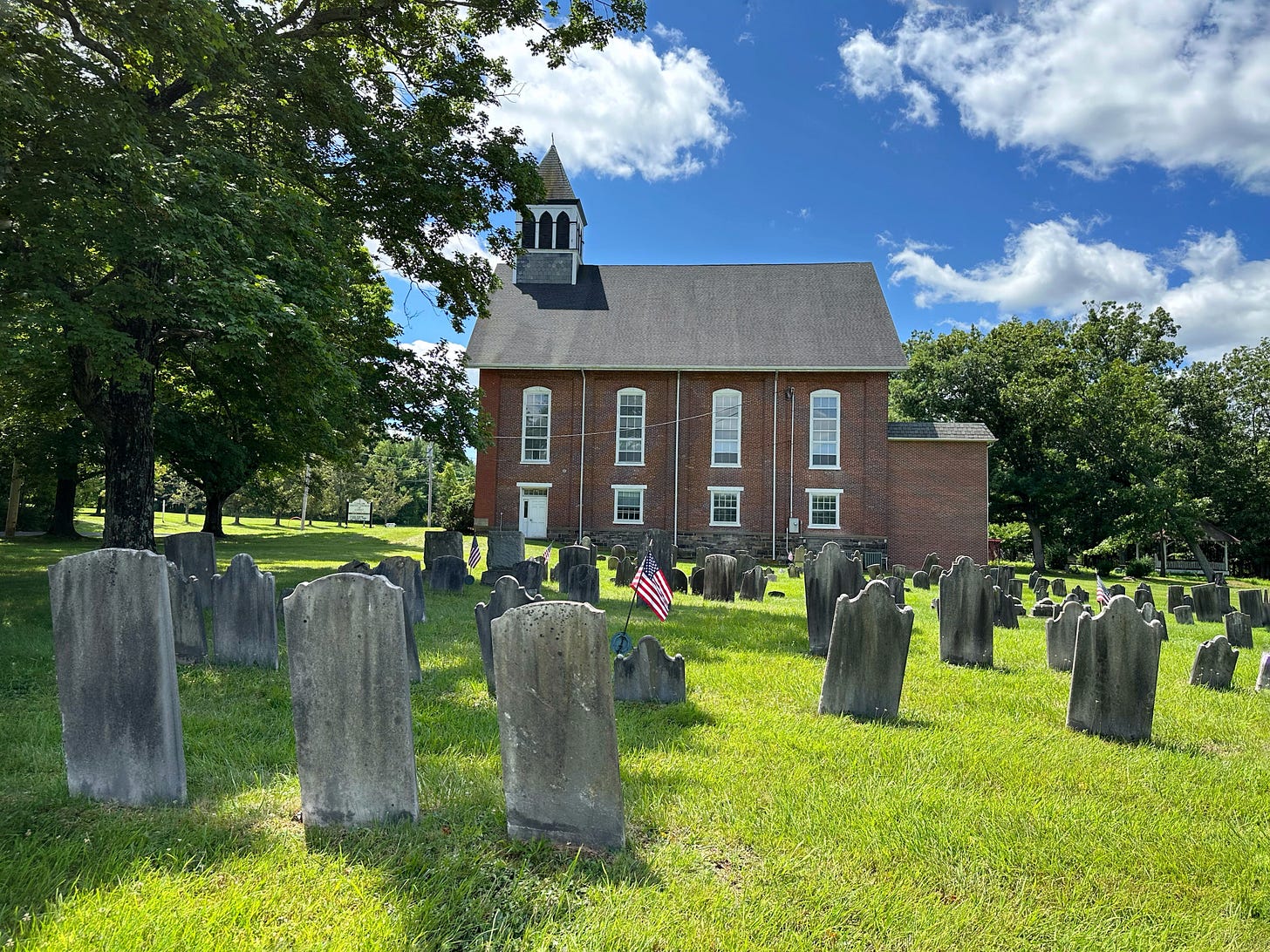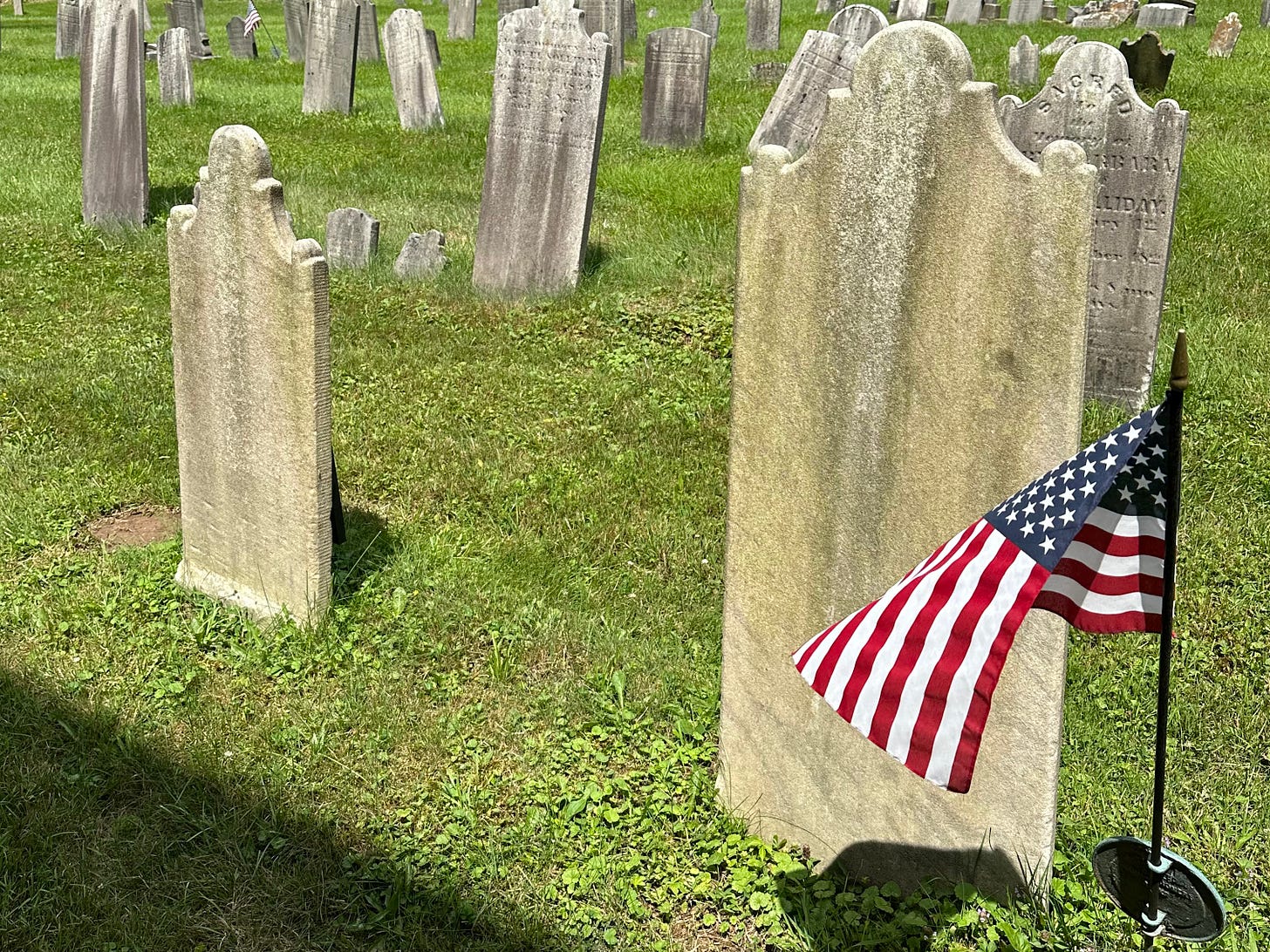Sunday Pastries With the Dead 32
The circa-1740 Lower Tinicum Union Cemetery in Tinicum, PA.
Today’s weather was a blessed departure from the scorchers of late, so I decided to tackle a larger cemetery that’s been on my list for a while. I drove, windows down, music blasting, out to the Pennsylvania countryside with a strong iced latte in hand. Bliss.
This part of the state was settled by Swedes in the mid-1600s (the area was known as “New Sweden”), and preaching began on this piece of land in 1739 (the first burial took place one year later in 1740).
Worship here was initially held in a log cabin built in 1789; by 1808, a larger brick church was erected. The current building, above, was expanded in 1861—though only the outer walls date back that far, as a fire gutted the structure in 1907 (the cause was believed to be lightning hitting the steeple).
There are three distinct burial sections surrounding the church, which mark its congregation’s growth through the years. The oldest is directly next to the building, the next-oldest is fenced off beside it—this plot was officially purchased for £3.00 (equivalent to £374.00 today) by congregation trustees in 1802—and the most recent is on the other side of the church with a view of sprawling farmland. All told there are almost 2,000 people interred here.
The oldest death date I was able to read was that of Mary Long, who died in 1795 when she was just 21 years old. And two remnants of the area’s early settlers remain—the headstone in the center translates to “Her Rest Susanna Bissy Daughter of Michel Worman Aug 24 Year 1797.” The language appears to be a combination of Russian and Luxembourgish—I’m not nearly educated enough in this subject, but perhaps this is a combination of what the early Swedish and German settlers in these areas spoke. Note also the score lines above and below the words on Susanna’s stone, showing the carver’s work to keep each letter even. Maria Margaretta Leidy Worman’s 1804-era stone on the right is tougher to read, but the words seem to be a combination of Dutch and German.
I found one maker’s mark here, on Samuel Hillpot’s cradle grave, though time has weathered the name and it’s hard to read. It looks like E. Weiss Richland…lossy? Richland…tson? None of my resources are showing me a match so the jury’s still out, but he was clearly doing beautiful work in the mid-to-late 1800s.
Editor’s note: since publication, one of my keen-eyed Instagram followers has solved this conundrum—the third word reads Richlandtown, indicating that E. Weiss worked out of Richlandtown, PA.
Speaking of carvers, I found some intriguing examples of work that was a bit rougher around the edges. Susanna Wyker’s 1822 stone shows us why those score lines on Susanna Bissy’s aforementioned marker are so important—you can see that not only are the letters wildly varying sizes, but the carver also ran out of room and had to break several words onto separate lines. The font (especially the cursive “In”) is pretty nice, so it’s possible that this was done by an apprentice or a more skilled rural carver.
Caty Shafer, Elizabeth Schafer, and William Shaffer are family members buried beside each other—and the wildly differing spellings of their last names along with the very simple, thin lettering indicate their stones’ carvers were less experienced. Elizabeth and William’s markers showcase different font styles (the lettering on William’s is quite wobbly), which points to either a professional assistant’s practice work or a rural carver pushing his limits.
You may recall the name of a notable person interred here, from SPWTD 28 about the Doan Outlaws. Eve (also known as Eva) Lear Piper is buried beside her husband Colonel George Piper; she’s the absolute legend who chased two of the Doan gang members out of her Inn by throwing a hot iron at them while brandishing George’s sword. George was a Revolutionary War hero and is the namesake of Pipersville, PA; he and Eve established Pipers Tavern in 1778 (now called the Historic Piper Taven).
Some of the more arresting symbols included Joseph Fox’s mini cemetery scene (the columns stand for a noble life), Maria M. Swope’s open book (aka the Book of Life) and wreath (eternal memory), and Albert Sackett’s intertwined hands (this symbol is repeated on his wife Rachel’s identical cradle grave beside him, and represents a marital handshake).
And finally, we end with a front and back view of 17-year-old Hannah Ort’s gorgeous Zinkie—see SPWTD 31 for more on the fascinating history of these metal monuments.
Until next Sunday, fellow taphophiles!












